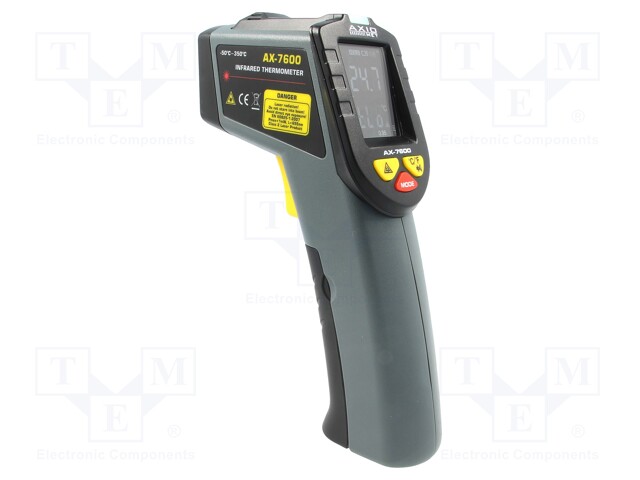Emission Factor and Its Influence on the Accuracy of Temperature Measurements.
Infrared radiation, also called thermal radiation, is emitted by each body with temperature higher than 0°K. Higher temperatures mean higher incident radiation.
The capacity to emit infrared radiation differs between particular materials. Its intensity is further influenced by the surface (its color, smoothness). Dark, matt objects emit more thermal radiation in comparison to those with light, smooth surface.
In order to achieve precise results, depending on the specifics of a particular examined object, a so-called Emission Factor (ε) is used. The factor should be taken into consideration during contactless temperature measurement
The benchmark for radiation measurements is a blackbody that completely absorbs radiation, regardless of the wave length, incidence angle, or the temperature of the radiating object. Its Emission Factor (ε) equals 1.
Emission values for different materials are contained within the range 0-1.
Values for the most commonly tested objects are listed in the table below.
| Material | Thermal Emissivity | Material | Thermal Emissivity |
|---|---|---|---|
| Asphalt | 0.90 to 0.98 | Material (black) | 0.98 |
| Concrete | 0.94 | Human Skin | 0.98 |
| Cement | 0.96 | Leather | 0.75 to 0.80 |
| Sand | 0.90 | Coal (Powder) | 0.96 |
| Soil | 0.92 to 0.96 | Varnish | 0.80 to 0.95 |
| Water | 0.92 to 0.96 | Varnish (flat) | 0.97 |
| Ice | 0.96 to 0.98 | Rubber (black) | 0.94 |
| Snow | 0.83 | Plastic | 0.85 to 0.95 |
| Glass | 0.90 to 0.95 | Wood | 0.90 |
| Ceramics | 0.90 to 0.94 | Paper | 0.70 to 0.94 |
| Marble | 0.94 | Chromium Oxide | 0.81 |
| Plaster | 0.80 to 0.90 | Copper Oxide | 0.78 |
| Masonry Mortar | 0.89 to 0.91 | Iron Oxide | 0.78 to 0.82 |
| Brick | 0.93 to 0.96 | Cloth | 0.90 |
The instrument for contactless temperature measurement (based on infrared radiation) is called a pyrometer. Its main advantage is quick measurement that does not influence the temperature of examined objects. A pyrometer with adjustable emission factor takes its value into account when converting the received radiation into temperature displayed on the screen.
In case of basic pyrometers, the emission factor has a fixed value of 0.95, typical for the majority of materials. For measuring materials with low emissivity (like metallic, varnished, or polished surfaces), pyrometers with adjustable emission factor should be used.
Using a pyrometer, you can also conduct spot temperature measurement. In order to conduct temperature measurement and present temperature distribution on a surface, thermal-imaging cameras should be used.














